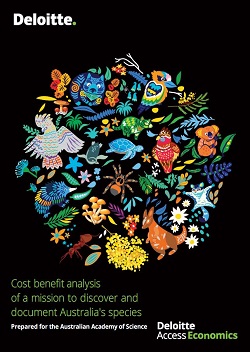Global S&T Development Trend Analysis Platform of Resources and Environment
| Mission to map Australia’s biodiversity predicted to bring big economic benefits | |
| admin | |
| 2021-06-02 | |
| 发布年 | 2021 |
| 语种 | 英语 |
| 国家 | 澳大利亚 |
| 领域 | 资源环境 |
| 正文(英文) |
A new report by Deloitte Access Economics has found every $1 invested in discovering all remaining Australian species will bring up to $35 of economic benefits to the nation. The cost-benefit analysis of the value of discovering new species has never before been attempted in Australia. It comes as scientists launch a new mission to discover and document all Australian species that remain undiscovered and unnamed within a generation. The 25-year mission being launched today is led by the Australian Academy of Science’s Director of Taxonomy Australia, Adjunct Associate Professor Kevin Thiele. He says many Australians would be surprised to know that after more than 300 years of Western scientific exploration of Australia’s rich biodiversity, only 30% of Australia’s estimated 750,000 species have been named and documented so far. “Without this mission, it’s likely to take more than 400 years to discover all remaining Australian plants, animals, fungi and other organisms. A 16-fold increase in the annual rate of discovery is required over the next 25 years to meet this ambitious goal. “Combining the skills of our current and future scientists with new technologies such as genome sequencing, artificial intelligence and supercomputing makes this ambitious goal achievable by 2050.
“The successful completion of this mission will help build a path to a sustainable and prosperous future and place Australia among the first nations in the world to benefit from a fully documented biodiversity,” he said. The mission is also expected to:
The estimated cost of building capability needed to document the remaining estimated 600,000 Australian species yet to be discovered is $824 million over 25 years. Initial focusThe mission’s initial focus will be to develop assets, including a national biobank and DNA sequence library, to ensure DNA sequences are available for all known Australian species. This would unlock enormous potential, from eDNA sequencing for environmental monitoring to bioprospecting, bioindustries and bioengineering. Adjunct Associate Professor Thiele says the collection of more than 70 million scientific specimens in museums and herbaria in every Australian state and territory represents a $7 billion national science infrastructure and a solid foundation on which to build such a national biobank. Insect expert Dr Erinn Fagan-Jeffries from the University of Adelaide is one of the Australian scientists involved in Taxonomy Australia’s new mission. Dr Fagan-Jeffries is researching the biodiversity and taxonomy of parasitoid wasps in Australia. She recently discovered and named four new species of wasp in collaboration with primary schools in regional South Australia. 
Deloitte Access Economics partner and principal report author, Matt Judkins, says the modelling and analysis indicate that Taxonomy Australia’s mission is both ambitious and has strong potential to create significant economic and social benefits for the country. “Benefits in the sectors of biosecurity, biodiscovery, agricultural R&D and biodiversity conservation attributable to accelerated taxonomic discovery range from $3.7 billion to $28.9 billion over the period to 2045, depending on the low, medium or high scenario cases defined for each benefit stream. This compares to the costs of investment in seven key categories estimated at $824 million over the same period. “While a significant investment, and a lot of good will, will be required, Australia will have access to a much better understanding of its biodiversity and the risks it faces,” Mr Judkins said. This report aligns with the 10-year plan for taxonomy and biosystematics developed by the Australian Academy of Science and the Royal Society Te Apārangi. This decadal plan seeks to use new and emerging technologies, develop key infrastructure, and create a unified and dynamic science that will serve the needs of society, government, industry and our unique biodiversity. Find out more about Taxonomy Australia, a program of the Australian Academy of Science. |
| URL | 查看原文 |
| 来源平台 | Australian Academy of Science |
| 文献类型 | 新闻 |
| 条目标识符 | http://119.78.100.173/C666/handle/2XK7JSWQ/327022 |
| 专题 | 资源环境科学 |
| 推荐引用方式 GB/T 7714 | admin. Mission to map Australia’s biodiversity predicted to bring big economic benefits. 2021. |
| 条目包含的文件 | 条目无相关文件。 | |||||
| 个性服务 |
| 推荐该条目 |
| 保存到收藏夹 |
| 查看访问统计 |
| 导出为Endnote文件 |
| 谷歌学术 |
| 谷歌学术中相似的文章 |
| [admin]的文章 |
| 百度学术 |
| 百度学术中相似的文章 |
| [admin]的文章 |
| 必应学术 |
| 必应学术中相似的文章 |
| [admin]的文章 |
| 相关权益政策 |
| 暂无数据 |
| 收藏/分享 |
除非特别说明,本系统中所有内容都受版权保护,并保留所有权利。
修改评论